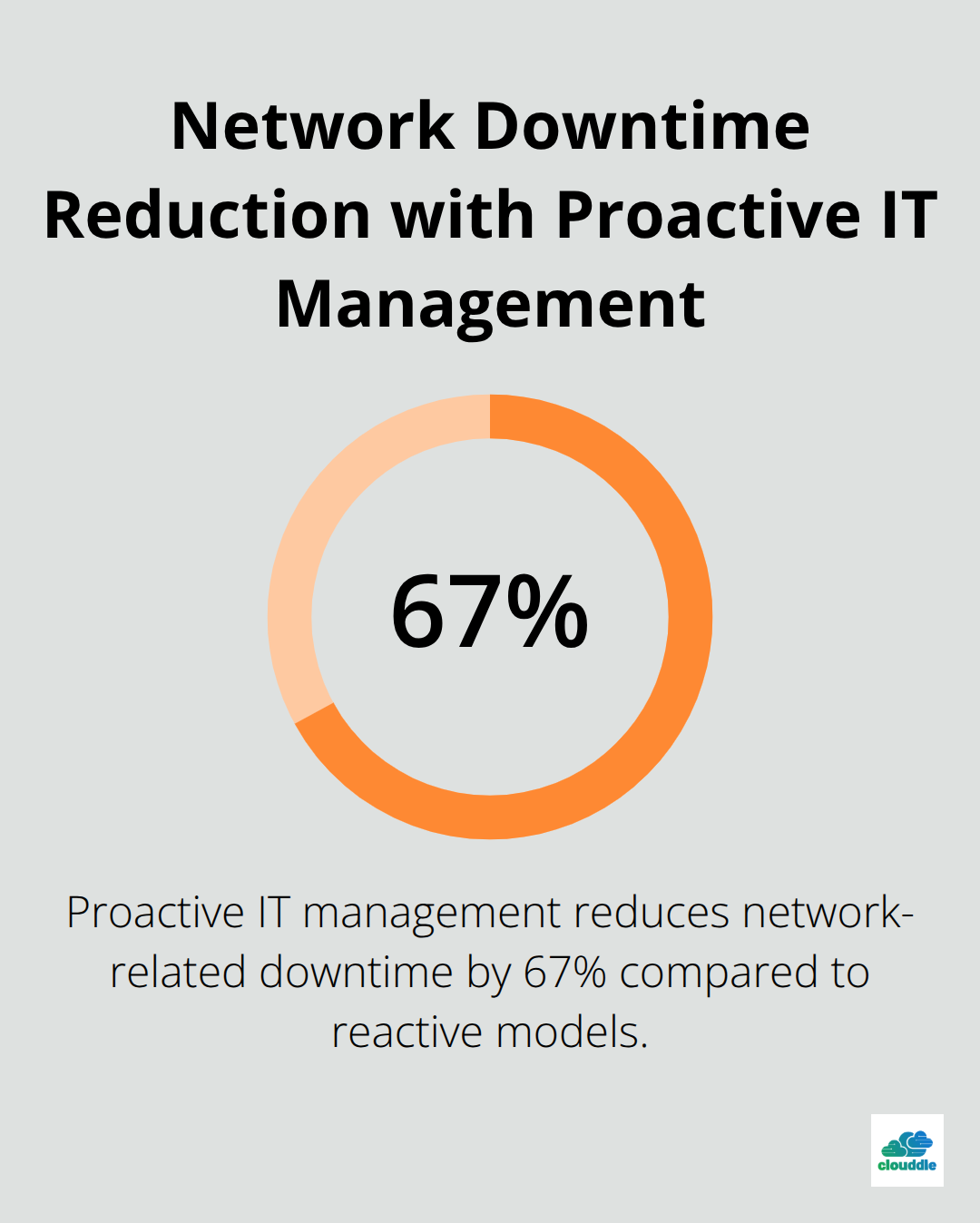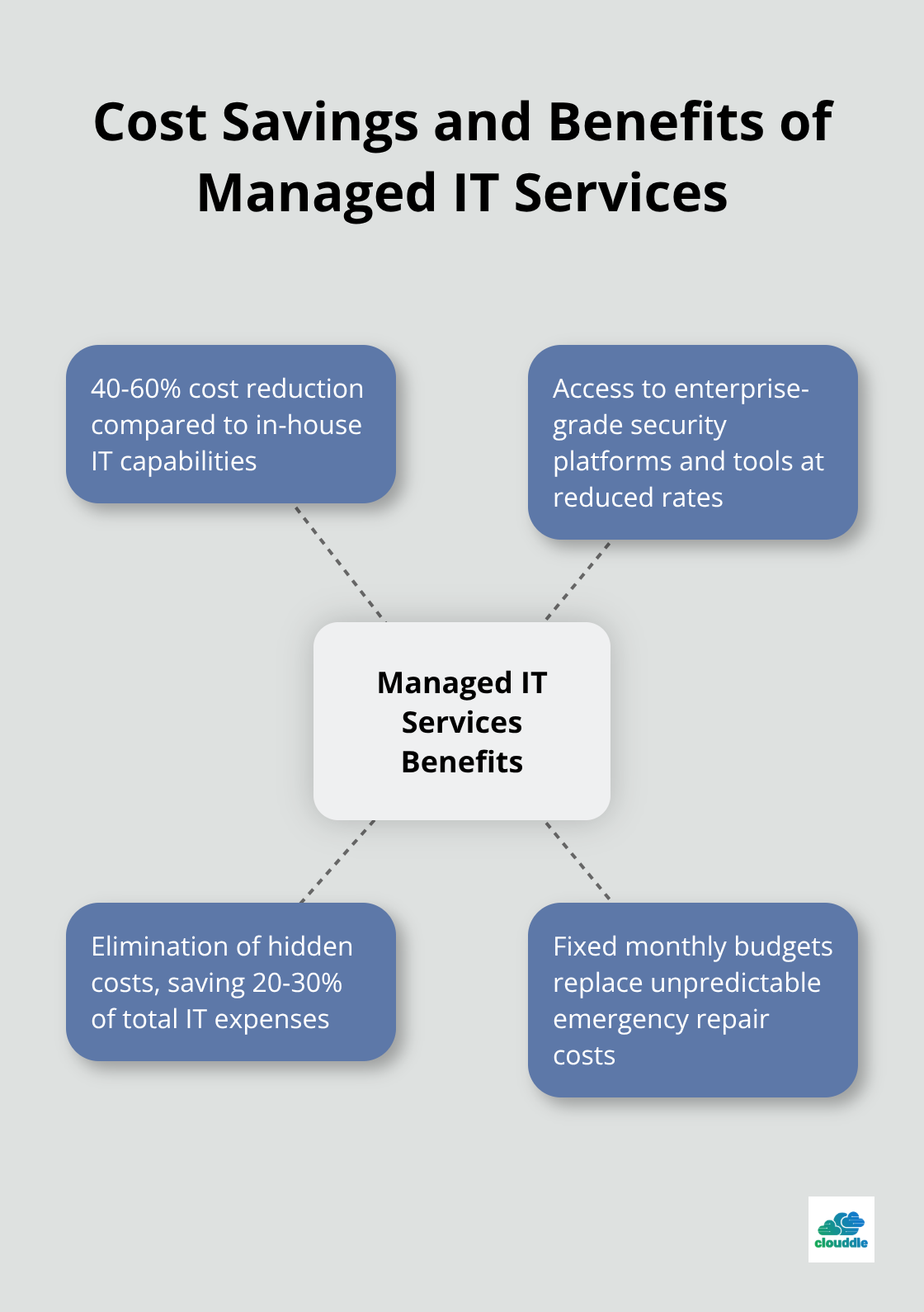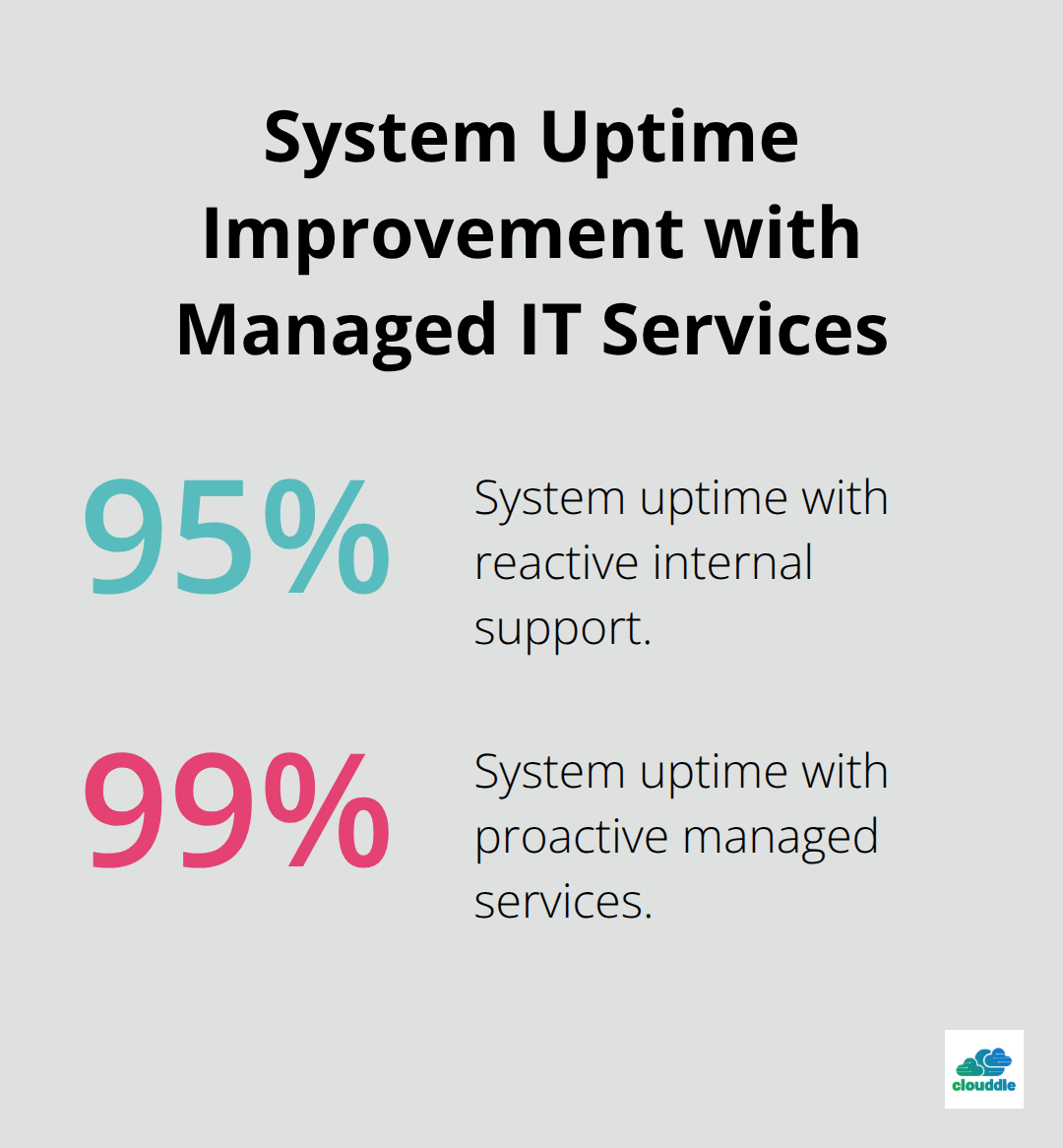Small businesses lose an average of $137,000 per hour during IT downtime, according to Gartner research. The importance of managed IT services has never been more apparent as companies struggle with complex technology demands.
We at Clouddle see businesses transform when they partner with the right managed service provider. Professional IT management reduces costs while improving system reliability and security.
What Services Do Managed IT Providers Actually Deliver
Managed IT services operate through three core components that directly impact your business operations and bottom line. Round-the-clock network monitoring forms the foundation, with providers who track server performance, bandwidth usage, and system health metrics every minute. This continuous oversight helps maintain system reliability, with professional monitoring teams responding to alerts within 15 minutes on average, compared to hours or days when businesses rely on internal staff who handle multiple responsibilities.
Network Infrastructure Management
Network monitoring extends beyond simple uptime checks to include performance optimization and capacity planning. Providers analyze traffic patterns, identify bottlenecks, and recommend infrastructure upgrades before performance degrades. They maintain detailed network maps, monitor switch and router health, and track wireless access point performance across your entire facility. This proactive approach reduces network-related downtime by 67% compared to reactive maintenance models.

Comprehensive Security Operations
Cybersecurity services encompass threat detection, incident response, and compliance management rather than simple antivirus installation. Managed security teams monitor network traffic for suspicious activity, maintain firewall configurations, and conduct regular vulnerability assessments. They implement multi-factor authentication, manage security patches, and provide employee security training programs. Data breaches cost businesses $4.88 million on average, making comprehensive security management a financial necessity rather than a luxury option.
Cloud Platform Optimization
Cloud infrastructure management involves strategic planning, cost optimization, and performance monitoring across multiple platforms. Providers handle cloud migrations, manage backup systems, and optimize resource allocation to prevent overprovisioning costs. They monitor cloud spending patterns, recommend rightsizing opportunities, and implement automated scaling policies. Professional cloud management typically reduces infrastructure costs by 30% while it improves system performance and reliability metrics.
These comprehensive services create measurable financial benefits that extend far beyond simple technical support.
How Much Money Does Managed IT Really Save
A full-time IT professional demands $75,000 annually on average, plus benefits that add another 30% to total compensation. Technical certifications require $3,000-$15,000 per employee yearly, which compounds training expenses significantly. Managed service providers eliminate these staffing costs entirely while they deliver expertise across multiple specializations. A single MSP contract typically costs 40-60% less than equivalent in-house capabilities, according to CompTIA research.
Fixed Monthly Budgets Replace Emergency Repairs
Break-fix IT models create unpredictable expenses that devastate quarterly budgets without warning. Data center outages cost businesses more than $100,000, with many incidents exceeding $1 million in damages. Managed services operate on flat monthly fees that include hardware maintenance, software updates, and technical support. This predictable model allows accurate budget forecasts and eliminates surprise expenses that force businesses to delay growth investments.
Enterprise Technology Without Enterprise Prices
Small businesses gain access to $100,000+ security platforms, advanced tools, and enterprise-grade backup systems through managed service partnerships. Individual software licenses for comprehensive security suites cost $50-$200 per user monthly, while managed providers bundle these tools at reduced rates. Professional-grade firewalls, intrusion detection systems, and compliance management platforms become accessible to companies with 10-50 employees who could never justify individual purchases (making enterprise technology affordable for smaller operations).
Hidden Costs That Disappear
Internal IT teams require ongoing education, vendor management, and administrative overhead that businesses often overlook. Software licensing renewals, hardware warranty tracking, and compliance documentation consume significant time and resources. Managed providers handle these administrative burdens while they maintain vendor relationships and negotiate better rates. The elimination of these hidden costs (often 20-30% of total IT expenses) creates additional savings beyond direct staffing reductions through effective cost-saving strategies.

These financial advantages translate directly into operational improvements that transform how businesses function daily.
How Do Managed IT Services Transform Daily Operations
Professional IT management transforms business operations through measurable performance improvements that directly impact productivity and revenue. System uptime increases from 95% to 99.9% when businesses switch from reactive internal support to proactive managed services. This improvement means 43 fewer hours of downtime annually, which translates to $5.9 million in prevented losses for mid-sized companies. Managed providers detect hardware failures 72 hours before they occur through automated systems, while internal teams typically discover problems only after systems crash.

Proactive Monitoring Prevents System Failures
Advanced tools track 200+ system metrics continuously, including CPU usage, memory consumption, disk space, and network latency patterns. Temperature sensors in server rooms, power supply voltages, and hard drive health indicators receive constant surveillance through sophisticated dashboards. When metrics exceed predetermined thresholds, automated alerts trigger immediate technician response within 8-15 minutes on average. This proactive approach prevents 89% of potential system failures before they impact operations (compared to reactive models where businesses lose 4.2 hours per incident while they wait for diagnosis and repair).
Response Speed Determines Financial Impact
Technical issue resolution accelerates dramatically with managed services, which drop response times from 24-48 hours to under 2 hours for critical problems. Managed providers maintain staffed help desks with tier-one technicians available immediately, tier-two specialists within 30 minutes, and senior engineers on 4-hour notice. Internal IT staff juggle multiple responsibilities including vendor management, procurement, and strategic planning, which creates delays when urgent issues arise. Professional service level agreements guarantee specific response times with financial penalties for providers who miss targets (creating accountability that internal teams cannot match).
Strategic Resource Reallocation
Internal teams redirect 60-70% of their time from technical problem resolution to strategic business initiatives when managed services handle routine maintenance and support. Administrative staff stops handling password reset requests and printer troubleshooting calls, which allows them to focus instead on customer service and revenue activities. Management gains access to detailed IT performance reports, budget forecasts, and strategic technology roadmaps that guide future investments rather than emergency decisions. Automation significantly reduces manual workload and minimizes human error across daily operations.
Final Thoughts
The importance of managed IT services becomes clear when businesses examine the financial and operational evidence. Companies reduce IT costs by 40-60% while they gain access to enterprise-grade security platforms and 24/7 monitoring capabilities that prevent $137,000 hourly downtime losses. Professional management transforms system uptime from 95% to 99.9%, which creates measurable productivity gains across all departments.
Strategic partnerships with managed service providers deliver long-term value beyond immediate cost savings. Businesses redirect internal resources toward revenue activities while professional teams handle complex technology challenges. Predictable monthly costs replace emergency repair expenses, which enables accurate budget planning and strategic growth investments.
When you evaluate providers, examine their response time guarantees, security certifications, and industry-specific experience. Clouddle specializes in hospitality, multi-family properties, and senior communities with Network as a Service solutions that combine networking, entertainment, and security without upfront investment (eliminating capital expenditure barriers). Their 24/7 support and flexible contracts address the unique operational demands these industries face daily.


